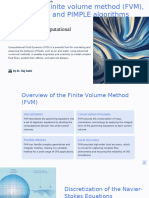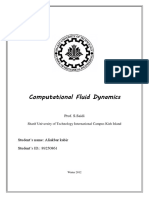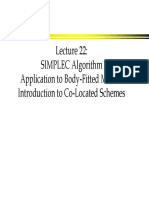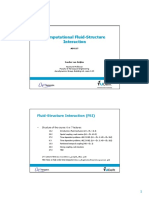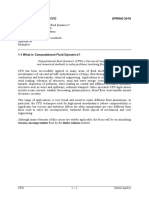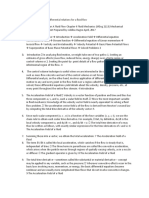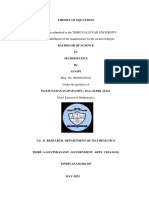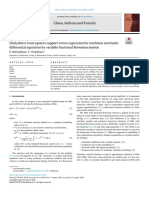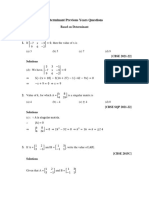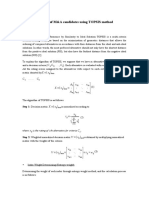1 CFD Course FVM- SIMPLE ALGORITHM
Pressure-Velocity Coupling
In practical flow solvers, we have a set of coupled pde’s. In 3-D
this involves determining U, V, W and P, as well as any additional
quantities (temperature, enthalpy, turbulence energy, etc) that may
be required.
We have already examined how to discretize the momentum
equations to obtain U, V and W. Pressure gradients appear in
these, so we need a method to determine the pressure
distribution.
However, the 4th equation we have is the continuity equation –
which does not actually contain the pressure explicitly.
In this lecture we thus consider a strategy for handling the
coupling between the velocity and pressure fields in a flow
computation.
We restrict attention to 2-D steady-state flow, and work within a
finite volume framework on a simple rectangular mesh. The same
methods are readily extended to 3-D and more complex grids.
The equations we need to solve, are then
(1)
1
�2 CFD Course FVM- SIMPLE ALGORITHM
where Su and Sv represent any other source terms that may be
present (from buoyancy, rotation, turbulent stresses, etc).
Before considering how to obtain the pressure field, we first examine
alternative storage arrangements that can be used for the
discretized flow variables, since these have a bearing on how
source terms are represented, and thus on how the schemes to be
described may be implemented.
Storage Arrangements
◮ The U momentum equation can be integrated over the control
volume shown below, resulting in a discretized equation of the form
(2)
where Sup is source terms arising from integrating the pressure
gradient over the cell, and Su represents any other source terms.
On the grid shown, Sup would be given by
(3)
2
�3 CFD Course FVM- SIMPLE ALGORITHM
A convenient storage arrangement is to use a single set of control
volumes, with all variables stored at the same locations (collocated).
An advantage of this is that all geometrical data is only stored once.
However, this arrangement does also have some
disadvantages.
With collocated storage we must interpolate between PP and PE to
get Pe, the pressure at the east face of the cell (similarly for the
west face).
On a uniform grid, this interpolation gives
(4)
so there is a relatively weak linkage between the velocity and local
pressure field (as PP is not used).
This can lead to chequerboarding: an unphysical pressure field that
oscillates from node to node can appear as uniform to the
discretized momentum equation.
3
�4 CFD Course FVM- SIMPLE ALGORITHM
Methods are available to overcome this problem. However, for
now we consider an alternative arrangement that results in a stronger
linkage between adjacent pressure and velocity values.
A much stronger coupling between the velocity and pressure
field nodal values is obtained by using a staggered grid.
In this arrangement the velocity components are stored at the
centers of the faces of the pressure control volume.
4
�5 CFD Course FVM- SIMPLE ALGORITHM
A disadvantage of this is there are separate control volumes for
U, V and P, so more geometrical information has to be stored.
Such overheads become particularly harmful in non-orthogonal
and 3-D grid arrangements.
The pressure gradient term in the equation for Ue is now simply
(5)
giving a direct coupling between adjacent velocity and pressure
values.
Pressure Correction Schemes
The problem in obtaining the pressure field arises because,
although we have 3 equations for U, V and P, the continuity
equation does not explicitly contain P.
The momentum equations provide us with a set of discretized
equations which can be solved for U and V, if we know the
pressure field. However, we cannot use the continuity equation
directly to obtain P.
Instead, we consider how an iterative procedure can be used to
adjust the pressure field in order to ensure that the resulting
velocity field does satisfy continuity.
Such schemes are generally referred to as Pressure Correction
schemes.
5
�6 CFD Course FVM- SIMPLE ALGORITHM
At each iteration a ‘correction’ to the pressure distribution is
calculated, designed to drive the local velocity field towards one
that satisfies both momentum and continuity equations.
The SIMPLE Scheme
A widely-used pressure-velocity coupling scheme is the SIMPLE
(Semi Implicit Method for Pressure Linked Equations) scheme
(Patankar, 1980), which is outlined in the following.
The discretized momentum equations for Ue and Vn are written as:
(6)
Because of the staggered grid, Ue is a nodal value of U, and Vn a
nodal value of V. The summations on the right hand sides are
contributions from surrounding (neighboring) nodal values; Sup and
Svp are pressure-related source terms, and Su and Sv any other
source terms.
After dividing through by the diagonal coefficient, the discretized
momentum equations can be written in the form
(7)
where , , and
Starting off with some initial values for the pressure field, the
above equations can be solved to obtain U and V.
However, these will not, in general, satisfy the continuity equation.
6
�7 CFD Course FVM- SIMPLE ALGORITHM
Now suppose we add corrections U′, V′, P′ to the velocities and
pressure so that the corrected variables
(8)
satisfy both the momentum and continuity equations.
Substituting into the discretized momentum and continuity
equations, we attempt to solve for the corrections U′, V′, and P′.
Substituting these corrected values into the discretized momentum
equations gives:
(9)
Subtracting equations (7) from these, gives
(10)
which provide relations between the pressure and velocity corrections
ensuring the momentum equations are still satisfied.
To simplify the analysis, we now split the velocity and pressure
corrections into two parts: U′ = U′1+U′2 etc. Then we can write
7
�8 CFD Course FVM- SIMPLE ALGORITHM
(11)
In the SIMPLE scheme, the two correction parts are chosen such
that
(12)
This choice of split ensures a simple linkage between U′1, V′1 and P′1
values. The more complicated term involving velocity corrections at
neighbouring nodes is put into the second part of the correction.
Since we want the corrected velocities to satisfy continuity, we
now examine the discretized continuity equation. Integrating the
continuity equation over the pressure control volume leads to
(13)
(14)
where Sm = (eUe−wUw)y +(nVn−sVs)x is simply the mass
imbalance arising from the original U, V field.
8
�9 CFD Course FVM- SIMPLE ALGORITHM
As a first approximation, we assume the second part of the
corrections
(U′2, V′2, P′2) may be neglected. Substituting equations (12) into the
discretized continuity equation then results in
(15)
After collecting up terms the above equation can be written in the
form
(16)
where
This set of linear equations for the pressure correction P′1 can be
solved, using the same methods employed for solving the
discretized momentum equations.
The corresponding corrections to the velocities, U′1 and V′1, are
then obtained from equations (12), and the pressure and velocities
are thus all updated.
9
�10 CFD Course FVM- SIMPLE ALGORITHM
Since the SIMPLE scheme is typically embedded within an
iterative flow solver, the whole algorithm is:
1. Start with initial values
2. Solve momentum equations to get U, V
3. Calculate coefficients and source terms for the pressure correction
equation (15)
4. Solve for the pressure corrections P′1
5. Calculate velocity corrections U′1, V′1 from equations (12)
6. Update P, U, V
7. Repeat from step 2 until solution has converged.
10






